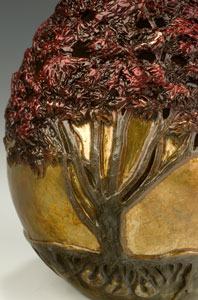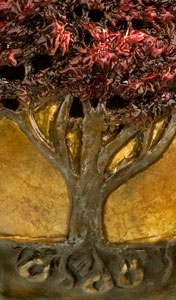edition of 193
5.5″ h x 4.5″ w

Sweet Aries Maple
inspiring me to trust
my voice above all others
Sweet Aries Maple
calling me to be willing to be first
when the season is ripe<
Sweet Aries Maple
keys raining upon the earth
with the potent Wind
Sweet Aries Maple
spinning keys bringing delight
to children – and adults – everywhere
Sweet Aries Maple
reminding us of the Great Power
and of our power – at once

Inspiration
Many admire the Japanese maple tree for its strikingly beautiful range of reddish foliage – from brilliant crimson to burgundy maroon. Others smile, at sight or mention of any maple, recalling fond childhood memories of playing with its fallen keys (seeds).
While I share in both delights, Aries Maple was inspired by neither. My inspiration was primarily warm childhood memories of the Japanese maple tree growing in the front yard on our small farm. Among the many trees on our farm, and throughout the countryside, the small Japanese maple was my childhood favorite. I grew quite slowly in my early years. The Japanese maple, with its naturally smaller skeleton, always felt ‘just my size’ for climbing and resting. I could climb it without any assistance! My Japanese Maple was the only tree – for many years – that I could climb all by myself.
The two-legged maple keys are designed for the wind to easily carry them great distances. The keys are smaller on the Japanese maple than on other maples. They spin in their dance to the earth, using their two blades to truly fly with the wind. Perhaps this is why so many adopted the nickname helicopters? The wind, for me, has long held the symbolic significance of Spirit. I use a mark on each of my vessels, adjacent to my signature, symbolic of the Wind – mark of appreciation and gratitude remembering that I never create alone. For me, the strong movement of the wind has always been a hopeful reminder that the Spirit is always moving, regardless of what we each are doing/seeing.
It’s interesting that the maple is one of the first trees to blossom/seed – at a time when most other trees are just beginning to awaken from their winter slumber. Mighty maple dares to ‘go first’, seemingly in a great hurry to blossom first then drop its seeds for the growth of a new season. I very much appreciate the idea of always being in a hurry to grow into a new season. One of the primary characteristics of the astrological sign Aries is that of a delight and willfulness in ‘going first’. Hence, the title of this vessel, Aries Maple, seems appropriately befitting.
My Aries Maple vessel has nine keys in the root system which surround the bottom region. Nine is symbolically a number of completion. I felt a connection to this willingness to ‘go first’ and release to the Wind- especially in these times when we are socially completing one huge historical chapter and beginning a new one. These are the times when we are each called to ‘go first’ with great confidence and courage. We are invited to ‘go first’ and try something vitally different – to consider all our choices with fresh and vibrant eyes. We are invited to look and act differently, regardless of the choices of those surrounding us.
And so it is, Aries Maple is born. The edition size of 190 reflects the number 1 for being first, and the number 9 for completion. It is my hope Aries Maple and Maple Joys will inspire each of us to be willing to look with fresh eyes ‘first’ rather than waiting for another. Change is up to each of us, and thankfully if we each simply bloom as naturally and quickly as possible, Spirit will carry our seeds far and wide – perfectly.

Japanese Maple Facts
- The seeds of the Japanese maple are often referred to as samaras or keys. Common slang nicknames for the two-legged seed pods include helicopters, whirly-gigs and whirlybirds.
- The seed’s inherent design helps the wind to propel them great distances on their journey from branch to ground, spinning as they fly and fall.
- Typically, the Japanese maple produces its first blooms well before other local trees – flowering in late winter or the earliest days of spring (sometimes with or even before the leaves spout). Seed maturation is a few weeks to six months after the flowers appear.
- The Japanese maple’s red leaves are 5 or 7 palmed and pointed.
- Typically a small, slow-growing tree, the Japanese maple often matures into a domelike form. Some species can live to be more than 100 years old. Its older bark is grayish while the fresher bark is green or reddish.
- According to Joan Maloof’s book, Teaching the Trees (2007), the Japanese maple produces chemicals which are distasteful to forest tent caterpillars and gypsy moth caterpillars – two of the most serious tree defoliators in eastern North America.
